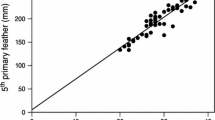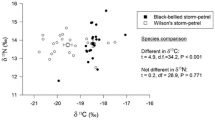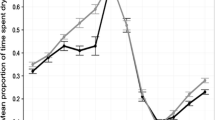Abstract
To determine whether stable isotope measurements of bird feathers can be used to identify moulting (interbreeding) foraging areas of adult seabirds, we examined the stable-carbon (δ13C) and nitrogen (δ15N) isotopic composition of feathers of chicks and adults of black-browed albatrosses (Diomedea melanophrys) from Kerguelen Islands, southern Indian Ocean. Albatross chicks are fed primarily fish (75% by mass), the diet being dominated by various species of the family Nototheniidae and Channichthyidae which commonly occur in the shelf waters in the vicinity of the colony. δ13C and δ15N values in chick feathers, which are grown in summer in the breeding area, were lower than values in adult feathers, which are grown in winter (δ13C: –19.6‰ versus –17.6‰ and δ15N: 12.4‰ versus 15.7‰, respectively). No differences in δ13C and δ15N values were found in adult wing feathers moulted in 1993 and 1994 and in adult feathers formed at the beginning, middle and end of the 1994 moulting period. These data are consistent with adults moulting in the same area and feeding at the same trophic level from one year to the next and with no major changes in foraging ecology within a given moulting season; they suggest that foraging grounds were different in summer and winter and that these differed in their stable-isotope signature. Changes in both feather δ13C and δ15N values indicated feeding south of the Subtropical Front (STF) during chick rearing, which is in agreement with the known foraging ecology at this time and feeding north of the STF during moult. This, together with band recoveries from adult birds, indicates that black-browed albatrosses from Kerguelen Islands wintered in subtropical waters off southern Australia. The stable-isotope markers in feathers, therefore, have the potential for locating moulting areas of migratory seabird species moving between isotopically distinct regions and for investigating seabirds’ foraging ecology during the poorly known interbreeding period. Such information is needed for studies of year-round ecology of seabirds as well as for their conservation and the long-term monitoring of the pelagic environment.
Similar content being viewed by others
Author information
Authors and Affiliations
Additional information
Received: 28 June 1999 / Accepted: 14 September 1999
Rights and permissions
About this article
Cite this article
Cherel, Y., Hobson, K. & Weimerskirch, H. Using stable-isotope analysis of feathers to distinguish moulting and breeding origins of seabirds. Oecologia 122, 155–162 (2000). https://doi.org/10.1007/PL00008843
Issue Date:
DOI: https://doi.org/10.1007/PL00008843




